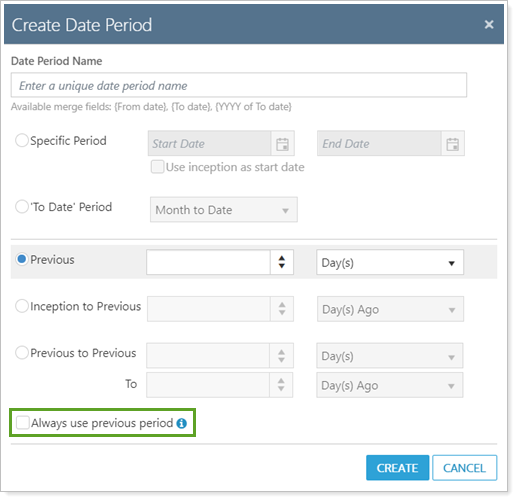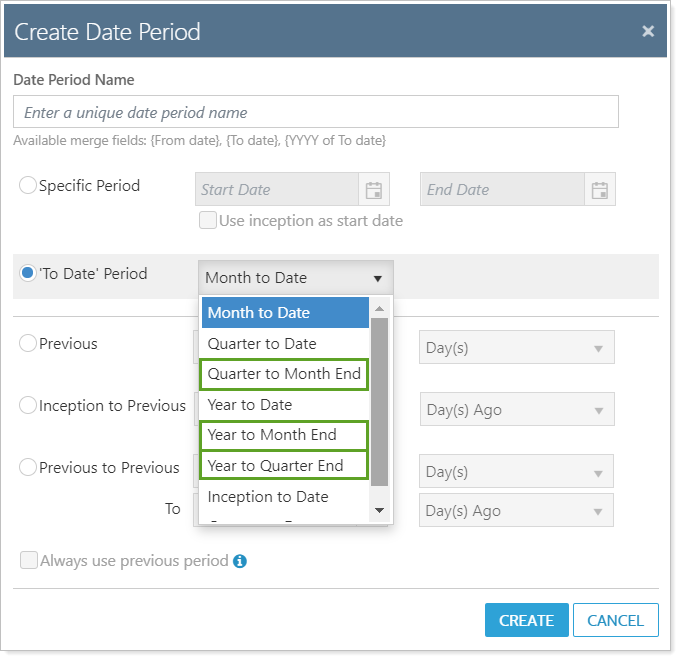Contents
|
|
Customize the Previous Date Period Types When Used at the End of a Date Period
The previous date period types (Previous, Inception to Previous, and Previous to Previous) let you define a date period relative to today. However, we heard your feedback that you were getting unexpected results when using a previous date period type at times that fall at the end of that date period range. If you were to run a report at year end, you may notice that the Previous 1 Year(s) and Year to Date date period would produce the same results. If today is the last day of 2019, you may want that date period to be 2018, not 2019.
Because of this, we added an additional way to customize how the previous date period types are calculated with the Always use previous period option.

This setting lets you define the date period as always the period of time previous to the one you're currently in, even on the last day of the period.
Example
Today's as of date is December 31, 2019 (12/31/2019) and you are running a report using the Previous 1 Year(s) date period.

If you select Always use Previous Period, the resulting date period on this report would be 2018.

If you clear Always use Previous Period, the resulting date period on this report would be 2019.

This option lets you further customize date period behavior and eliminates confusion, especially when you use a date period at the end of that defined period of time.
For more information, see Dates and Date Periods.
Better Align Date Periods Between Client Statements and Client Portals
We know clear and consistent communication with clients is an important part of any firm's practice and we heard your feedback about inconsistencies between the date periods clients see on their quarterly statements and the dates they see in client portals. Clients could be confused if they're expecting to see one consistent date range in both places.
With this release, we added new date period options to help you communicate date periods more consistently to match the dates shown on quarterly statements and the dates shown on other reports in Tamarac Reporting, including reports on client portals. We added the following new options when setting up 'To Date' Period:
-
Quarter to Month End
-
Year to Month End
-
Year to Quarter End

These options close the gap between date periods that stay current relative to today's date and date periods that reflect a client's last quarterly statement. These date period options use the following logic:
| 'To Date' Option | Description of Date Period | Expected Output |
|---|---|---|
| Quarter to Month End | Begins as the beginning of the quarter and ends at the end of the previous month |
|
| Year to Month End | Begins at the beginning of the year and ends at the previous month |
|
| Year to Quarter End | Begins at the beginning of the year and ends at the previous quarter end |
|
Platform Improvements & Performance Enhancements
Part of our ongoing effort to improve the speed and reliability of the Tamarac Platform includes a number of enhancements under the hood. This table highlights improvement we made since our last release:
| Improvement Made | Type of Improvement |
|---|---|
|
We improved the way we process reporting requests when using Advisor View by reducing database calls and improving calculation processing. In some cases, this improved reporting request time by 10%. |
Code/Database |
|
We added a load balancer tool to help evenly balance requests and improves performance for those clients who were experiencing notably long morning sync run times. This tool helps eliminate data bottlenecks and improves the performance of the sync performance. |
IT/Infrastructure |
Learn More - Watch the Release Video


